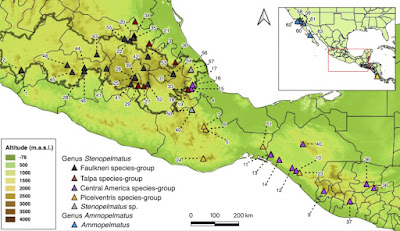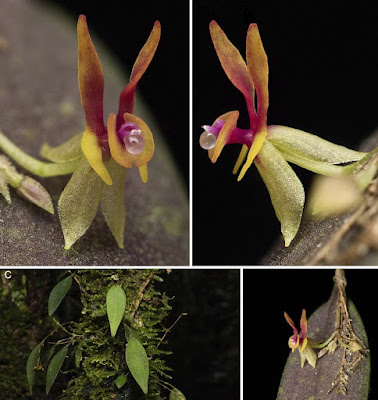 |
Vaccinium paradoxum M.N.Tamayo & P.W.Fritsch,
in Tamayo & Fritsch, 2022. |
Abstract
Vaccinium paradoxum is described as a new species of blueberry from the lowland ultrabasic forest of Northern Sierra Madre Natural Park, Luzon Island, Philippines. It resembles V. halconense, but differs by having shorter inflorescences, fewer flowers per inflorescence, a glabrous inner surface of the corolla, absence of anther spurs, and a glabrous style. Vaccinium paradoxum is unique among the currently known blueberries in Malesia by the presence of sessile glands borne on the pedicel and predominantly near the centre or scattered on the calyx lobes. It is also the only known Philippine Vaccinium to inhabit lowland ultrabasic forest on sea cliffs.
Keyword: Blueberry, lowland ultrabasic forest, Malesia, taxonomy, Vaccinioideae, Vaccinium halconense
 |
Vaccinium paradoxum M.N.Tamayo & P.W.Fritsch.
Distribution of sessile glands borne on the pedicel and predominantly near the centre of the lobes. Legend: calyx lobes (Cl); glands (Gl); hypanthium (Hp); pedicel (Pd); style (St; broken).
From the holotype. |
 |
Vaccinium paradoxum M.N.Tamayo & P.W.Fritsch.
A. Habit. B. Distal half of leaf showing marginal glands. C. Inflorescence. D. Pedicel and hypanthium. E. Oblique view of hypanthium showing calyx and disk. F. Dorsal view of stamen. G. Lateral view of stamen.
Illustration by Maverick Tamayo. Based on the holotype. |

Vaccinium paradoxum M.N.Tamayo & P.W.Fritsch, sp. nov.
Diagnosis: Vaccinium paradoxum resembles V. halconense Merr. by its leaf shape, leaf dimension, and flower color, but differs by having shorter inflorescences (1.3–3.5 cm vs. 5.0–7.0 cm), fewer flowers per inflorescence (5–8 vs. 10–15), glabrous inner surface of corolla (vs. pubescent), absence of anther spurs (vs. present), and a glabrous style (vs. pubescent). Moreover, the sessile glands borne on the pedicels and predominantly near the centre or scattered on the calyx lobes of V. paradoxum is a unique character among Vaccinium in Malesia (Fig. 2).
Distribution and Habitat: The new species is currently known only from the type locality in the lowland ultrabasic forest of NSMNP at ca. 20 m asl on sea cliffs.
Etymology: The epithet “paradoxum” is from the Latin meaning, in part, puzzling or unusual. This is in reference to the unique presence of sessile glands borne on the pedicel and predominantly near the centre of the calyx lobes of the new species.
Maverick N. Tamayo and Peter W. Fritsch. 2022. Vaccinium paradoxum (Vaccinieae, Ericaceae), An Unusual New Species from Sea Cliffs on Ultrabasic Forest of Luzon Island, Philippines. Taiwania. 67(3); 408-412.










































